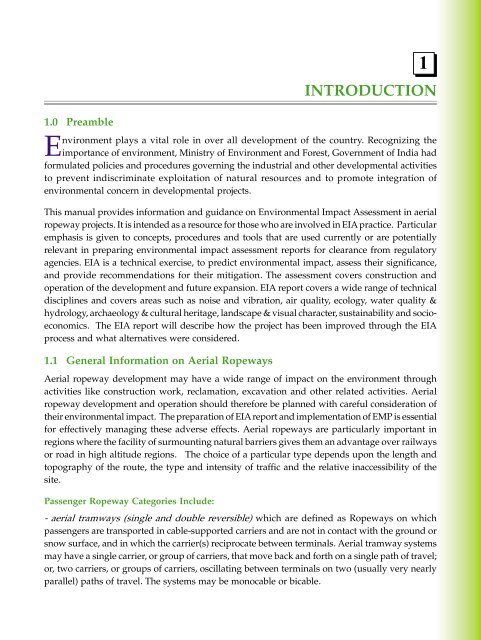Aerial Ropeways - Environmental Clearance
Aerial Ropeways - Environmental Clearance
Aerial Ropeways - Environmental Clearance
Create successful ePaper yourself
Turn your PDF publications into a flip-book with our unique Google optimized e-Paper software.
1.0 PreambleEnvironment plays a vital role in over all development of the country. Recognizing theimportance of environment, Ministry of Environment and Forest, Government of India hadformulated policies and procedures governing the industrial and other developmental activitiesto prevent indiscriminate exploitation of natural resources and to promote integration ofenvironmental concern in developmental projects.This manual provides information and guidance on <strong>Environmental</strong> Impact Assessment in aerialropeway projects. It is intended as a resource for those who are involved in EIA practice. Particularemphasis is given to concepts, procedures and tools that are used currently or are potentiallyrelevant in preparing environmental impact assessment reports for clearance from regulatoryagencies. EIA is a technical exercise, to predict environmental impact, assess their significance,and provide recommendations for their mitigation. The assessment covers construction andoperation of the development and future expansion. EIA report covers a wide range of technicaldisciplines and covers areas such as noise and vibration, air quality, ecology, water quality &hydrology, archaeology & cultural heritage, landscape & visual character, sustainability and socioeconomics.The EIA report will describe how the project has been improved through the EIAprocess and what alternatives were considered.1.1 General Information on <strong>Aerial</strong> <strong>Ropeways</strong><strong>Aerial</strong> ropeway development may have a wide range of impact on the environment throughactivities like construction work, reclamation, excavation and other related activities. <strong>Aerial</strong>ropeway development and operation should therefore be planned with careful consideration oftheir environmental impact. The preparation of EIA report and implementation of EMP is essentialfor effectively managing these adverse effects. <strong>Aerial</strong> ropeways are particularly important inregions where the facility of surmounting natural barriers gives them an advantage over railwaysor road in high altitude regions. The choice of a particular type depends upon the length andtopography of the route, the type and intensity of traffic and the relative inaccessibility of thesite.Passenger Ropeway Categories Include:- aerial tramways (single and double reversible) which are defined as <strong>Ropeways</strong> on whichpassengers are transported in cable-supported carriers and are not in contact with the ground orsnow surface, and in which the carrier(s) reciprocate between terminals. <strong>Aerial</strong> tramway systemsmay have a single carrier, or group of carriers, that move back and forth on a single path of travel;or, two carriers, or groups of carriers, oscillating between terminals on two (usually very nearlyparallel) paths of travel. The systems may be monocable or bicable.1INTRODUCTION
















